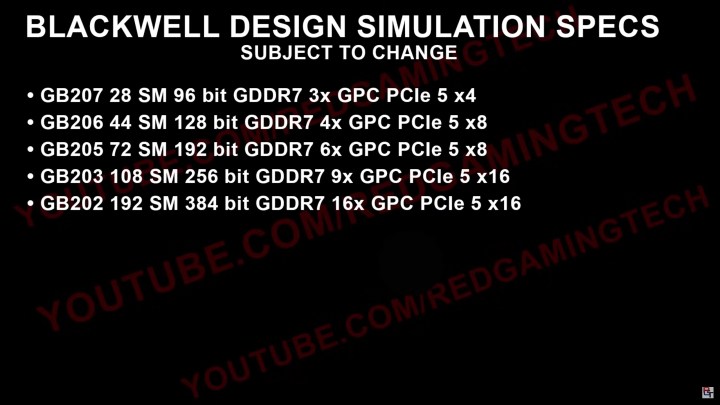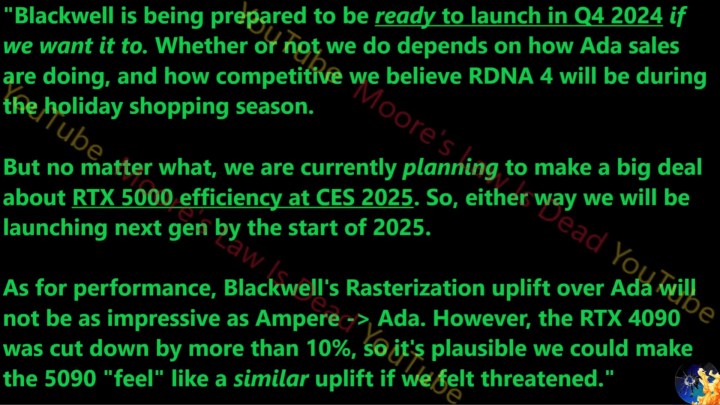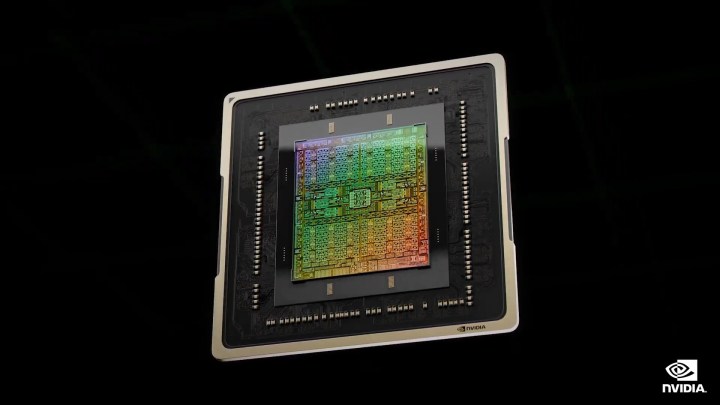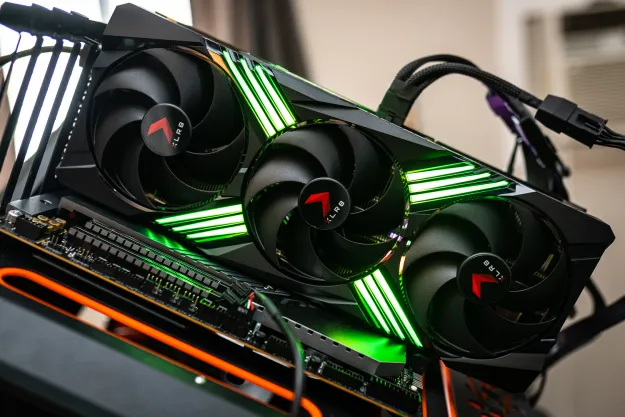
Nvidia already makes some of the best graphics cards, but it’s also not resting on its laurels. Although the RTX 40-series, which has been bolstered by a refresh, is still very recent, Nvidia is also working on its next-gen GPUs from the RTX 50-series.
The release date of RTX 50-series GPUs is still far away, but various rumors and leaks give us a better idea of what to expect. Here’s everything we know about Nvidia’s upcoming generation of graphics cards.
RTX 50-series: Specs
| Nvidia RTX 50-series | |
| Process node | TSMC 3nm |
| Architecture | Blackwell |
| Chip | GB202, GB203, GB205, GB206, GB207 |
| Memory type | GDDR7 |
| Maximum bus width | 384-bit/512-bit |
| Display connectors | DisplayPort 2.1, HDMI 2.1 |
With the release of RTX 50-series GPUs still a long while away, Nvidia hasn’t confirmed any specifications for any of the cards. In fact, we’re not even sure which models are on the way. However, piecing together speculation from various hardware leakers gives us some idea of what we can expect. Remember to take the following with a healthy dose of skepticism until Nvidia itself spills the beans.
TSMC3
— kopite7kimi (@kopite7kimi) November 15, 2023
We know for a fact that the follow-up to Ada Lovelace will be called Blackwell, honoring American mathematician David Blackwell. Rumor has it that it will be manufactured by TSMC based on a 3nm process, but it’s unclear whether Nvidia will be using one of TSMC’s existing 3nm nodes or a custom node.
The lineup is said to include chips spanning from the high-end, RTX 4090-equivalent GB202 through the GB203, GB205, GB206, and entry-level GB207. If proven true, this will be an interesting, or perhaps worrying, change. It would mean that the AD104 GPU powering the RTX 4070 has no successor in the next generation. It’s possible that the RTX 5070 and RTX 5070 Ti might, therefore, utilize the GB205 chip.
One of the most talkative sources of information on the RTX 50-series has been kopite7kimi on X (formerly Twitter). The leaker revealed that we can expect the new GPUs to feature support for DisplayPort 2.1, something that the Lovelace lineup doesn’t provide, and also for HDMI 2.1.
I think my persistence is correct. So the difference is that GB202 is 512-bit and AD102 is 384-bit.
— kopite7kimi (@kopite7kimi) March 11, 2024
Kopite’s latest update talks about the memory interface for Blackwell. The leaker now states that the flagship card will indeed have a 512-bit memory bus, despite their previous statements that it would stick to 384-bit. The maximum bus width of Blackwell has been a very contentious topic among popular leakers, so it’s hard to know what’s true. However, one thing that they all agree on is that Nvidia will use the new GDDR7 memory standard, which AMD is said not to be using in its upcoming RDNA 4 lineup.
The leaker also updated the expectations for the speed of those GDDR7 memory modules found in the RTX 50-series. Despite previous rumors that stated we might see 32Gb/s modules right out of the gate, kopite7kimi says that Nvidia will use 28Gb/s for this generation. This still marks a solid upgrade over Ada, delivering up to 1.8TB/s of memory bandwidth on the rumored RTX 5090 — assuming the 512-bit memory bus checks out.

A recent leak from YouTuber RedGamingTech gave us our first glimpse into what the specs could look like across the different chips in the lineup. This doesn’t exactly translate to a one-to-one product comparison, though. In fact, the RTX 4090 didn’t even max out its AD102 chip, so it’s very possible that we might see a repeat of this in Blackwell.
According to the specs shared by RedGamingTech, the flagship chip may come with 192 streaming multiprocessors (SMs), up from 144 in the AD102. The GB203 marks a massive step down, with just 108 SMs (up from 80 in the AD103). This implies that, if the RTX 5090 gets most of those SMs and the RTX 5080 is given the GB203 chip, there’ll be a huge performance gap between the two cards again — just like in this generation.
More speculation shared by kopite7kimi corroborates this. According to the leaker, the GB203 chip will be “half of GB202,” marking a similar drop in performance as what we’ve seen in the RTX 4090 versus the RTX 4080. It’s worth noting that RedGamingTech, unlike kopite7kimi, believes that we’re getting a maximum bus width of 384 bit.
I think GB203 is half of GB202, just like GB102 and GB100. But I don't know if GB202 has a multi chip package.
— kopite7kimi (@kopite7kimi) March 11, 2024
The amount of VRAM in GPUs has been a hot topic as of late, and to that end, RedGamingTech speculates that we might see up to 36GB of memory in the RTX 5090. However, those numbers aren’t finalized, so we might end up with 24GB like in the RTX 4090.
One last anecdote from the YouTuber states that the GB207, meaning the least performant chip in the lineup, will likely only appear in laptops at first. This tracks with what we’ve seen in the RTX 40-series, where the RTX 4050 has only made an appearance in laptops thus far.
It’s too early to know the specifics of any individual card at this point, and all of this is subject to change. It’s likely that Nvidia will release models ranging from the RTX 5060 to the RTX 5090, with some Ti options added into the mix. Let’s hope that it will keep the specs balanced to offer a good spread of cards for enthusiasts and entry-level users alike.
RTX 50-series: Pricing and release date

As far as the release date goes, we haven’t heard any specifics from Nvidia just yet — but most estimates pin the launch of Blackwell around the end of 2024 and the beginning of 2025. Some very tentative whispers even mention a possible RTX 50 refresh in 2026, but that’s way too far into the future to pay it much mind.
According to early rumors, Nvidia wasn’t supposed to be ready to launch the new graphics cards until 2025. This would give AMD a major edge, seeing as it’s rumored to launch RDNA 4 GPUs later this year. However, according to YouTuber and frequent leaker Moore’s Law Is Dead, Nvidia may not give AMD the breathing room it so badly needs.
Moore’s Law Is Dead said in a recent video that a source at Nvidia told him that “Blackwell is being prepared to be ready to launch in the fourth quarter of 2024,” but only if Nvidia wants it to. This depends on whether RDNA 4 will be competitive enough to take away sales from Nvidia during the holiday season at the end of this year, as well as how Ada sales are going around that time
No matter what, Nvidia is supposedly planning to “make a big deal about RTX 5000 efficiency at CES 2025.” This means that the GPUs are supposedly launching either at the end of 2024 or near the beginning of 2025.

The pricing of these GPUs is pure speculation at this point. In this generation, Nvidia adopted a pricing strategy that can only be referred to as “expensive.” It might follow down that path and push the prices even higher, especially if the demand for AI GPUs remains as high as it is right now. After all, the current demand pushed the RTX 4090 way above $2,000, even though it launched at an already very high price point of $1,600. This certainly makes the RTX 5090 a worrying prospect., but Nvidia’s recent price cut in the RTX 40-series Super refresh gave many enthusiasts some hope.
Assuming the flagship 5090 will cost close to $2,000, the rest of the lineup is unfortunately likely to follow with price increases across the board. However, for Nvidia to remain the go-to against AMD, the prices can’t keep rising forever. There is some hope that Nvidia will realize this and keep its pricing more reasonable in this next generation, but it’s too early to tell.
RTX 50-series: Architecture

Nvidia is keeping the architecture used in Blackwell chips hush-hush, but it won’t stay that way much longer. With the GPUs around a year away, we’ll learn more as the release date draws closer. For now, all we have is more speculation from various sources, but the information is often somewhat conflicting.
RedGamingTech talked about the Blackwell architecture at length in a recent video. The YouTuber referred to it as “one of the most influential graphics architectures,” predicting that the RTX 50-series will introduce significant improvements to things like path tracing and ray tracing, offering gains for both enthusiast-grade and midrange cards.
To that end, the YouTuber said we might see significant architectural changes, including a major redesign of Nvidia’s SMs. He also mentioned the addition of a denoising accelerator, either as a part of the chip or as a function of Nvidia’s Tensor cores. More importantly, RedGamingTech initially teased that Nvidia may use a multi-chip module (MCM) design. This means a design approach where multiple smaller chips are packaged together to form a single, larger, and more powerful processor. Switching to an MCM design over monolithic could give Nvidia a major edge, including scalability, higher yields, and more design flexibility.
Unfortunately, a recent update from the same YouTuber revealed that Nvidia won’t be using an MCM design in Blackwell. Reportedly, Nvidia initially planned to use dual GB202 dies glued together, possibly with some SMs cut, but ultimately decided against it. The YouTuber remarked that issues such as high prices, the latency between the two dies, and various difficulties in getting it to work made Nvidia stick to its previous architecture.
Take this with a healthy dose of skepticism. It’s possible that Nvidia may be planning to switch to MCM in the future, but such architectural changes are never made last minute, so that plan for Blackwell may have never existed. However, it’s also possible that Nvidia may introduce architectural changes instead of pushing for top performance toallow the new technology to mature before ramping up the performance in RTX 6000-series graphics cards a few years from now.
RTX 50-series: Performance

As the specifications of RTX 50-series graphics cards are still mostly a mystery, it’s hard to make any accurate predictions as to the performance of these GPUs. However, many have tried, which is why we have some juicy rumors to dig into while we wait for official benchmarks.
According to Moore’s Law Is Dead, the performance uplift between Ada and Blackwell may not be major. The YouTuber’s source mentioned that “Blackwell’s rasterization uplift over Ada will not be as impressive as [from] Ampere to Ada.” However, the source also said that Nvidia could make the RTX 5090 feel like a similar uplift “if it felt threatened.” That seems unlikely, seeing as AMD is reportedly stepping down from making high-end GPUs in the next generation, potentially leaving Nvidia as the only source of high-end graphics cards for the next couple of years.
Based on the above, we might be looking at performance gains along the lines of 30% to 50% for the flagship. Midrange and entry-level cards typically see a smaller boost in performance gen-on-gen, so those might be even less impressive.
However, on the other end of the spectrum is speculation from sources like RedGamingTech. The YouTuber claims in his video that we’re looking at an up to 2x increase in performance between Lovelace and Blackwell. He mentioned that the RTX 50-series should double the ray tracing performance compared to the RTX 40-series, as well as provide a performance boost of up to 2x. RedGamingTech is unsure if this means rasterization, though, so it’s hard to know the metric by which to measure these gains. He does, however, predict clock speeds reaching over 3GHz, which would be a sizable boost over Ada, but also says that this only applies to overclocked models.
In a later video, RedGamingTech added that we might see an up to 60% boost from one flagship to the next, meaning a 60% difference in performance between the RTX 4090 and the RTX 5090. The YouTuber also stressed that Nvidia’s focus was heavily on ray tracing and path tracing, with up to a 2.5x boost in those workloads. Again, approach all of this information with some skepticism.
The only real hint of performance figures we have right now comes from a slide made by Nvidia, but unfortunately, the slide talks about its next-gen high-performance computing (HPC) graphics card used in data centers. The graph, which measures GPU performance in GPT-3 175B inference, shows that the H200 GPU will be up to 18 times faster than the A100 — but that’s not Blackwell architecture yet. B100, the first Blackwell graphics card on the list, offers significantly higher performance, although Nvidia didn’t put a number on it. It looks to be about twice as fast as the H200.
While that’s exciting for those in need of an HPC GPU, gamers and other consumers will need to wait to find out the reality about the capabilities of RTX 50-series GPUs.
RTX 50-series: Power draw

Prior to the release of the RTX 40-series, the flagship RTX 4090 was the subject of a lot of rumors, and its power draw was an especially hot topic. Some sources claimed that the GPU would have truly monstrous power consumption, even reaching up to 900 watts. We now know that those claims were false, as the RTX 4090 consumes 450 watts, and its connector supports up to 600W — while occasionally melting. It’s hard to imagine that Nvidia will push those numbers even higher in the next generation of GPUs.
The RTX 50-series has been unable to avoid some power-related controversies, though. Moore’s Law Is Dead recently revealed that Nvidia is planning to use a whole new connector, which would mark the fourth such change in a span of just three years. The YouTuber cites anonymous sources, claiming that Nvidia is switching to a 16-pin connector, all dedicated to 12V power delivery. However, many other sources are pointing out that this is unlikely.
Hardware Busters reached out to its own sources and confirmed that “no one is aware of a new connector.” Nvidia would have to be working with major PSU brands, especially after the issues with the 12VHPWR connector. If these brands don’t know anything about it, Nvidia might not be making these changes in this generation yet.
Assuming Nvidia sticks to the (somewhat controversial) 12VHPWR connector that it’s currently using, the maximum power consumption will remain at 600W. The flagship RTX 5090 might go on to see an increase in power draw if it offers significantly more performance, but it’ll still need to leave some room for potential overclocking, so a maximum of 500W seems reasonable.
For the rest of the lineup, it’s possible that Nvidia will try to keep things more conservative instead of pushing for higher power consumption. As pointed out by NotebookCheck, Nvidia’s current trend of increasing total board power (TBP) is still fairly new — especially on cards like the RTX 4080. Historically, xx80 cards stayed well under 300W, even dipping below 200W at times. In the last couple of generations, the RTX 3080 and the RTX 4080 both pushed the TBP to new heights, with each requiring up to 320W.
With power consumption as high as this, it doesn’t make a lot of sense for Nvidia to keep pushing for even higher wattages, especially seeing as AMD is likely to keep it more conservative in RDNA 4. If Nvidia does dial it back a little, we might see the RTX 5080 with a TBP around 250W to 280W. However, if Nvidia sticks to its current scheme, it might go in the other direction and hit as high as 350W.
Editors' Recommendations
- Nvidia just made GeForce Now so much better
- The Nvidia RTX 4080 Super just trounced AMD
- Here’s how AMD counters Nvidia’s big RTX Super launch
- How to watch Nvidia’s launch of the RTX 4000 Super today
- Nvidia’s new GPUs could be right around the corner





